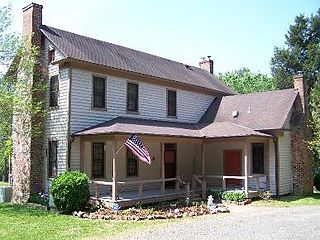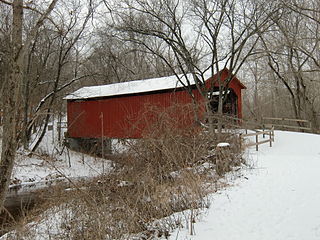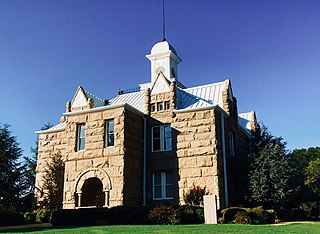
Albemarle is a small city and the county seat of Stanly County, North Carolina. The population was 15,903 in the 2010 Census. Gerald R. "Ronnie" Michael serves as Mayor and Albemarle has a seven-member City Council elected in a combination of at-large and district seats. Albemarle has operated under the Council-Manager form of government since 1962. Michael Ferris has served as City Manager since December 2014 and previously served as Assistant City Manager for nearly two decades. The City Manager is appointed by the City Council, and is responsible for the day-to-day administration of City government. The City's Department Heads report directly to the City Manager, who is also responsible for development and administration of the City's annual budget.

Cedar Creek and Belle Grove National Historical Park became the 388th unit of the United States National Park Service when it was authorized on December 19, 2002. The National Historical Park was created to protect several historically significant locations in the Shenandoah Valley of Northern Virginia, notably the site of the American Civil War Battle of Cedar Creek and the Belle Grove Plantation.

The Palmer-Marsh House is a historic house museum and National Historic Landmark on Main Street south of Carteret Street in Bath, North Carolina. Built in 1744, it is one of the oldest residences in North Carolina, and is a well-preserved example of a large colonial town house with a commercial space built in. It was declared a National Historic Landmark in 1970. It is now a North Carolina state historic site, and is open for tours.

Bentonville Battlefield is a North Carolina state historic site at 5466 Harper House Road in Johnston County, North Carolina. It belongs to the North Carolina Department of Natural and Cultural Resources and is the site of the 1865 Battle of Bentonville, fought in the waning days of the American Civil War. It was declared a National Historic Landmark in 1996.

The Joel Lane House, also known as Wakefield, was built in 1769, is a historic restored home and museum located in Raleigh, North Carolina. It is the oldest dwelling in Wake County and contains collections of 18th century artifacts and period furnishings. The museum grounds include a detached middle class home built circa 1790, formal city garden, and period herb garden. The house is named after Joel Lane, the "Father of Raleigh" and "Father of Wake County."

Hampton Plantation, also known as Hampton Plantation House and Hampton Plantation State Historic Site, is a historic plantation, now a state historic site, north of McClellanville, South Carolina. The plantation was established in 1735, and its main house exhibits one of the earliest known examples in the United States of a temple front in domestic architecture. It is also one of the state's finest examples of a wood frame Georgian plantation house. It was declared a National Historic Landmark in 1970.

The James Mangum House is a historic home located near Creedmoor, Wake County, North Carolina. Built in 1838, it is an example of Federal architecture. In November 1974, the James Mangum House was listed on the National Register of Historic Places.

Campbell's Covered Bridge is a wooden covered bridge in northeastern Greenville County, South Carolina, near the small town of Gowensville, and crosses Beaverdam Creek off Pleasant Hill Road.

Sandy Creek Covered Bridge State Historic Site is a publicly owned property in Jefferson County, Missouri, administered by the Missouri Department of Natural Resources, preserving the Sandy Creek Covered Bridge. The bridge is one of four remaining covered bridges in Missouri, which once numbered about 30. It is a relatively rare example of a Howe truss bridge, one of three in Missouri. The covered bridge is named for Sandy Creek, which it crosses, and was added to the National Register of Historic Places in 1970.

The Dillard Mill State Historic Site is a privately owned, state-administered property on Huzzah Creek in Crawford County, Missouri, that preserves a water-powered gristmill. The 132-acre (53 ha) site has been operated as a state historic site by the Missouri Department of Natural Resources under a lease agreement with the L-A-D Foundation since 1975. The site was listed on the National Register of Historic Places in 2015.

Carvers Creek State Park is a North Carolina state park in Cumberland County, North Carolina in the United States. Located north of Fayetteville, it covers 4,332 acres (17.53 km2) in the Sandhills region of the state. The park covers lands around Carvers Creek, a tributary of the Cape Fear River, and it borders Fort Bragg. The park is currently divided into two areas, Long Valley Farm and the Sandhills Property. The park is still being planned, and the state is planning to acquire more land for the park.

The historic Chickasaw Nation Capitols are located in Tishomingo, Oklahoma. The property consists of Chickasaw Council House Museum and the Chickasaw Nation Capitol building, which has been listed on the National Register of Historic Places since November 5, 1971.

Botany Bay Plantation Heritage Preserve/Wildlife Management Area is a state preserve on Edisto Island, South Carolina.

The China Ditch in Douglas County, in the U.S. state of Oregon, was a 30-mile (48 km) canal built in part by Chinese laborers to supply water for the hydraulic mining of gold. The Myrtle Creek Consolidated Hydraulic Gold Mining and Manufacturing Company began purchasing land for the ditch in 1890 and was bankrupt by 1894. Portions of the ditch, which carried water from Little River to North Myrtle Creek, remain visible, and an 11-mile (18 km) section is listed on the National Register of Historic Places.

The Asa Johnston Farmhouse is a historic farmhouse in Johnstonville, Conecuh County, Alabama. The one story, spraddle roof dogtrot house was built in 1842 by Ezra Plumb for Asa Johnston.

Walter R. and Eliza Smith Moore House is a historic home located near Clayton, Johnston County, North Carolina. It was built circa 1835. It is a two-story, four-bay, single-pile, vernacular Federal style heavy timber frame dwelling. It sits on a brick foundation, is sheathed in weatherboard, and has a two-story front portico. Also on the property is a contributing meat house.

Ellington-Ellis Farm is a historic home and farm complex located near Clayton, Johnston County, North Carolina. The house was built around 1835, and is a two-story, "T"-plan Greek Revival style heavy timber frame dwelling. It is sheathed in weatherboard, is flanked by exterior stone end chimneys, and has a low hip roof. It was remodeled in the 1850s that added a two-room kitchen/dining ell. Also on the property are the contributing smokehouse with a bell tower (1830s), a four-seat ladies' privy (1830s), and a playhouse (1850s).

Clayton Historic District is a national historic district located at Clayton, Johnston County, North Carolina. It encompasses 271 contributing buildings, 2 contributing sites, and 1 contributing structures in the town of Clayton. It includes notable examples of Late Victorian and Bungalow / American Craftsman style architecture and buildings dating from about 1850 to 1959. It includes commercial, residential, ecclesiastical, and educational structures. Located in the district are the separately listed Clayton Banking Company Building and the Clayton Graded School and Clayton Grammar School-Municipal Auditorium. Other notable buildings include the B.M. Robertson Mule Company stable, Mayo House, the Young House, Horne Memorial United Methodist Church, First Baptist Church of Clayton, and First Missionary Baptist Church.
























